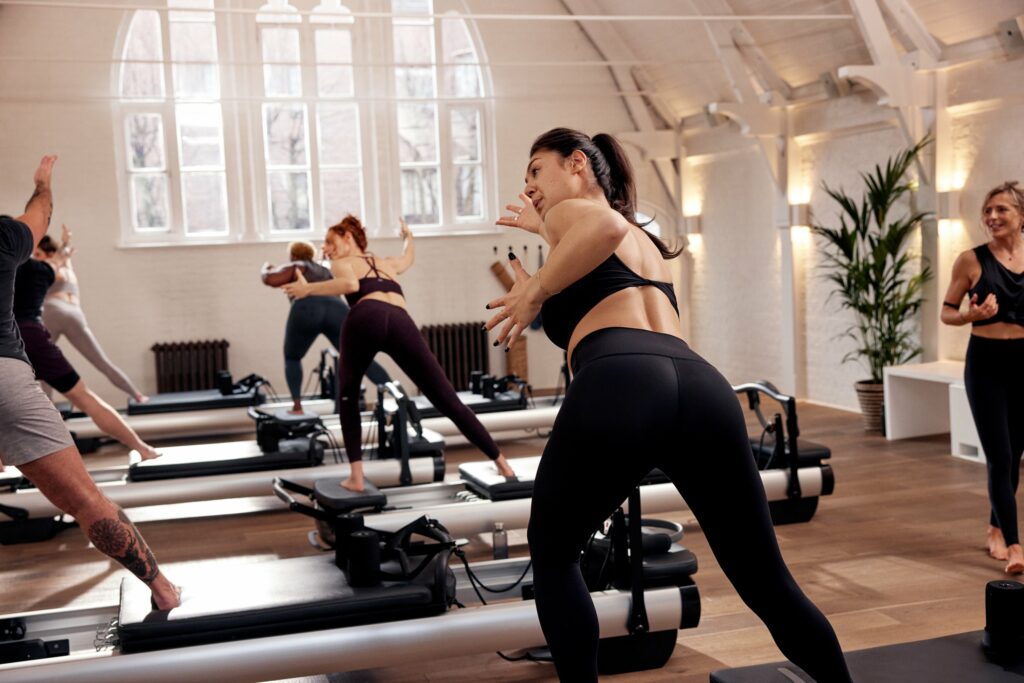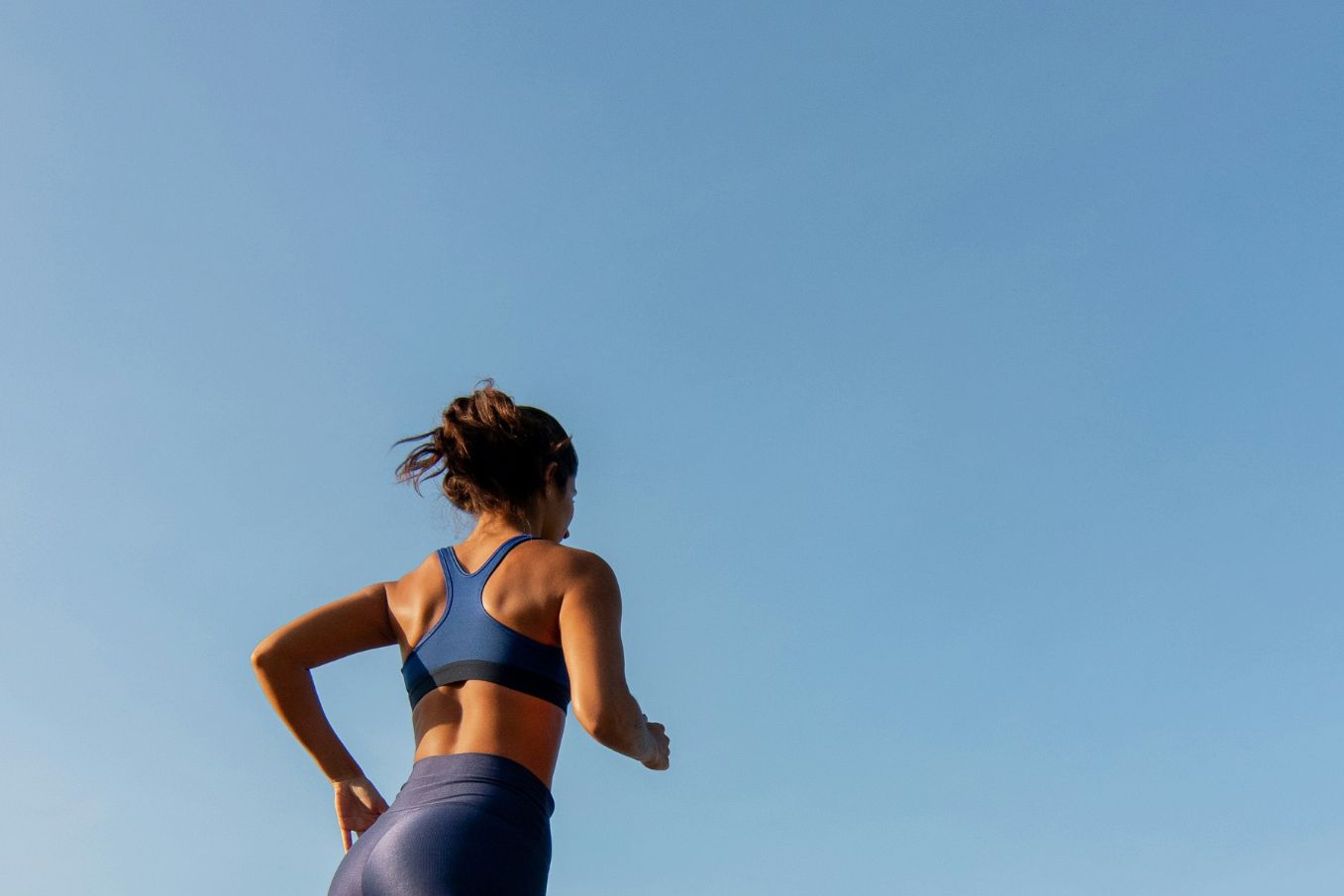Have you ever wished you could run faster, for longer, with more ease and a lot more power? Whether you’re a seasoned marathon runner or you’re hitting the pavements to unwind, Pilates could be your secret weapon…
A low-impact antidote to high-impact training, Pilates movements are designed to work deep into every muscle of the body, efficiently building long-term strength and flexibility – a critical combo for running. Plus, Pilates can help correct imbalances in the body, which can be a recipe for injury.
We caught up with former elite runner turned Heartcore teacher and PT Sophie K to explore the six reasons every runner should try Pilates.
6 ways to supercharge your run
“Pilates is brilliant for runners because it improves strength, flexibility and proprioception, all of which contribute to more efficient running form and faster recovery,” Sophie explains. “Lifestyle and work demands tax the body (too much time sitting on lazy glutes!) and so our muscular system switches off, putting huge stress on the ligaments, tendons and joints. Pilates encourages a happy and long spine, pelvic alignment, breath awareness and deep abdominal engagement, all of which are key for runners.” Here’s how…
1/ Core strength will protect you
A strong core and neutral spine and pelvis ensure you’re bearing your weight in the right places, which avoids overloading certain muscles and putting undue pressure on specific joints, such as the knees.
“Abdominal strength and engagement provide huge stability when you’re running,” says Sophie. “The impact is transferred from the lower body into the upper body through the core, and having a strong centre supports this. Your pelvis and spine is key in absorbing that impact.”
Sophie’s top tip for core strength is to focus on deep abdominal engagement; “It’s very easy to think that you are working your abs, but often you will only be activating the superficial layer of the core. Runners tend to have very tight hip flexors, so it’s really important to switch them off to enable a deeper connection.” Go for supine moves that involve lying on your back with feet flat on the floor or in a table top position, such as ab crunches, snow angels or chop downs – but making sure the lower back doesn’t arch!
2/ breath can be transformative
Pilates teaches deep, rhythmic breathing, a technique which will not only charge up your running endurance, but is a potent mood lifter.
“When things feel heavy in a run, when you feel like you need to stop or you’re struggling, having the Pilates breath to draw on is a powerful tool,” explains Sophie. “You’re probably slumping forwards at that point, restricting your lungs, so aim to open up through the front of your body, pull your shoulders back and down, run a little taller and slow your breathing down. Breathe in through the nose, out through the mouth: a few slow, deep breaths and suddenly you will feel calmer, you’ll run more efficiently, and it will bring peace into your body.”
3/ Say goodbye to tight hips
Hip mobility is absolutely key for runners, as the whole pelvic area tends to get very tight and congested. The hips are the gateway between the upper and lower body, absorbing a huge impact during running. Stretching alone isn’t enough, but by strengthening the glutes and hamstrings and by adding rotation, fluid movement and tension release – which Pilates is fantastic for – you will feel a difference.
“I love a Scrambled Egg,” says Sophie, referring to a Coreformer move that opens up the hips, while also working the opposite stabilising leg, the oblique muscles and glutes. “I spent years strength training, rolling and stretching, but my hips were still unhappy. As soon as I started Pilates, my hips were mobile and I noticed an immediate difference.”
Running is a sagittal movement – you move forward in a straight line – and one of the great advantages of Pilates is that it asks your body to move in different directions, to rotate, to move laterally and to be fluid, which it really needs to feel balanced.

4/ Find length and strength
Runners that have a habit of doing a couple of hamstring stretches at the end of a run will find the unique and dynamic moves of Pilates revolutionary.
“In the past I was guilty of not stretching enough and eventually my body started to struggle,” admits Sophie. “Runners tend to be quite tight through the front of the body – in the quads, hip flexors, psoas and chest – Pilates encourages length the front of the body and strengthens the posterior chain (upper back, glutes and hamstrings), reversing the pattern you find in runners.”
5/ Pilates powers up your legs
Powerful running combines stride and speed, and that comes in large part from the bum. Weak glutes can slow your pace, as well as forcing hips to work double time, straining muscles and causing injury. Luckily, Pilates activates all the glute muscles, to power up the posterior chain.
“We spend far too much time sitting down, and as a result, tension builds up through the hips and the hip flexors, and we lose strength in the glutes and hamstrings,” explains Sophie. “Single leg work is really important and there is always a focus on unilateral strength work, encouraging balance in the lower body.”
Given that glutes are a powerhouse for the back of your body, it’s key to get them fired up. Pilates moves for runners include any type of side-lying leg press or lunge, as well as a Skater – a beefy move for the glutes.
“As a runner, if you have strong glutes and hamstrings, it’s like someone is pushing you from behind,” says Sophie. “That power can increase speed, running efficiency and cadence. It’s the most wonderful feeling, having that strength powering you as you run.”
6/ pilates primes your upper body
Running isn’t all about the legs and glutes. It’s a whole body exercise, so strengthening the muscles that support you during a run – including the upper body muscles, both front and back – will elevate your experience.
As Sophie says, “Typically on longer runs your shoulders will round, which compresses the lungs. Opening through the chest and creating space is really key for maintaining good posture, particularly when the body gets tired.”
Posture can be improved with a move as simple as a seated row or a chest opener, bringing strength to the upper back and an opening through the chest.
Experience the benefits of Pilates for yourself – join us in our infrared heated mat studio, or meet us to the Coreformer®.
